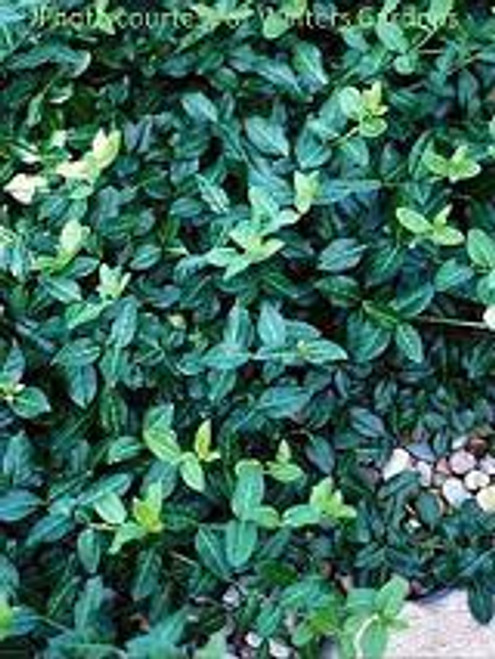Product Description
Euonymus fortunei 'Coloratus'
a/k/a Japanese Euonymus, purple leaf wintercreeper, wintercreeper euonymus, purple wintercreeper euonymus
Zone: 4 to 9.
Sun to Shade.
Mature size: 8 to 24 inches height; fast spreading, vine-like growth.
Extremely hardy, evergreen.
Dark green leaves in spring and summer and purplish red leaves in fall and winter. Dense, woody-stemmed, broadleaf trailing ground cover spreads as its many stems forms roots. Similar in habit to English ivy. Sparse greenish-white flowers may appear in June.
Sunny or shady area, Euonymus fortunei 'Coloratus' quickly forms a dense, weed-smothering ground cover or edger along paths or sidewalks, in containers, as a foundation planting or as an ivy-like climbing vine for covering walls, chimneys or fences. Excellent erosion control for slopes. One of the most popular evergreen ground covers. Perfect for large area coverage, hillsides and areas not easily accessed, as no shearing or other maintenance is required.
Euonymus fortunei 'Coloratus', also known as Purple Wintercreeper Euonymus, is a popular and versatile evergreen groundcover prized for its colorful foliage and adaptability. It is a great choice for adding texture and interest to gardens, especially in areas where other plants might struggle. Here is a closer look:
Appearance:
- Foliage: 'Coloratus' features small, oval-shaped leaves that emerge dark green in spring and summer. As temperatures cool in fall, the leaves transform into a beautiful reddish-purple hue, adding a vibrant touch to the winter landscape.
- Flowers: It occasionally produces small, inconspicuous greenish-white flowers in early summer, but the foliage is the main attraction.
Growing Conditions:
- Light: Thrives in full sun to full shade, making it a versatile choice for various garden settings. It can even tolerate deep shade.
- Soil: Adaptable to a wide range of soil conditions, including average, medium moisture, well-drained soils. It is tolerant of various soil types and pH levels.
- Hardiness Zones: Hardy in USDA zones 4-9, making it suitable for a wide range of climates.
Uses:
- Groundcover: 'Coloratus' excels as a groundcover, quickly forming a dense mat that helps to suppress weeds and prevent erosion.
- Edging: It is also a great choice for edging walkways or borders, adding a touch of color and definition.
- Slopes and Banks: Its spreading habit makes it useful for stabilizing slopes and banks.
- Climbing: While primarily a groundcover, 'Coloratus' can also climb if given support, reaching up to 20 feet or more. However, it is less vigorous as a climber compared to other Euonymus varieties.
- Containers: It can be grown in containers, where its trailing foliage can spill over the edges, adding a touch of greenery to patios and balconies.
Additional Benefits:
- Evergreen: It retains its foliage year-round, providing continuous color and interest.
- Fall and Winter Color: The reddish-purple fall and winter foliage adds vibrancy to the landscape when many other plants have died back.
- Low Maintenance: It is a relatively low-maintenance plant that does not require much care once established.
- Tolerates Urban Conditions: It is tolerant of urban pollution and other challenging conditions.
Things to Consider:
- Invasive Potential: In some areas, 'Coloratus' can become invasive, spreading aggressively and potentially crowding out other plants. It is important to monitor its growth and control its spread if necessary.
- Pruning: It can be pruned in early spring to maintain its shape and size.
- Pests: It can be susceptible to euonymus scale, so it is important to monitor for infestations and treat as needed.
Overall, Euonymus fortunei 'Coloratus' is a valuable and versatile groundcover that offers year-round interest, adaptability, and low maintenance. Its colorful foliage, especially in fall and winter, makes it a standout in any garden.
Eighteen (18) plants in 3.5-inch containers per flat (or tray).
Other Details
The most important part of the plant is its root system. Healthy roots are the foundation of a healthy, vibrant plant. The type of plug container used is based on the specific needs of the plants. Perennials offered as bare root traditionally perform better when planted as bare root.Planted in a specialized mix, potted plants have well established root systems. Top growth stage will vary depending on the current life cycle and time of year when shipped. In Winter and early Spring dormant plants may be shipped. Dormant plants may be planted right away, even before the last frost date.
Most bare root varieties are field grown for at least one season, though Hemerocallis and Hosta are grown for two seasons. The bulk of the soil is removed during the harvesting process and the tops of most varieties are trimmed back to the crown. They are graded, packed in shredded aspen or sphagnum moss and stored in freezers until ready to be shipped.
See our Container Sizes and Bare Root Perennials pages for more information.
Plant information and care is provided in the Overview section, Plant Genus Page and general information is provided in the Planting Care & Guides. Additional questions can be asked on each Plant page.
Plant Spacing: Using the maximum mature spread or width of a plant to guide spacing, ensures space to grow to full size. To fill an area sooner, plant them closer together. Just remember, future thinning or transplanting may be needed.
Water: Keep a close eye on newly planted perennials, especially throughout the first growing year. Most early plant loss is due to too much or too little water!















